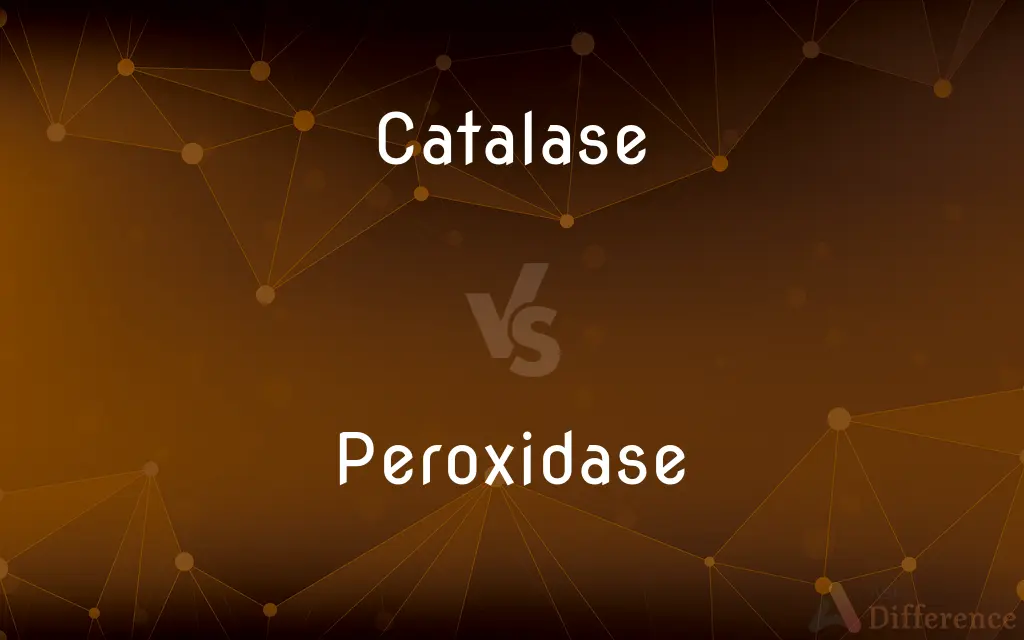Catalase vs. Peroxidase — What's the Difference?
By Fiza Rafique & Urooj Arif — Updated on March 21, 2024
Catalase rapidly decomposes hydrogen peroxide into water and oxygen, whereas peroxidase catalyzes the oxidation of various substrates using hydrogen peroxide.

Difference Between Catalase and Peroxidase
Table of Contents
ADVERTISEMENT
Key Differences
Catalase is an enzyme found in nearly all living organisms exposed to oxygen, where it catalyzes the decomposition of hydrogen peroxide to water and oxygen. On the other hand, peroxidase enzymes are a broad group that catalyze the oxidation of various substrates by hydrogen peroxide, often yielding water and an oxidized product.
The primary function of catalase is to prevent the accumulation of hydrogen peroxide, a harmful byproduct of cellular metabolism, protecting cells from oxidative damage. Peroxidase, however, plays a more diverse role, including in processes like lignin synthesis in plants, detoxification, and in the immune system.
Catalase is known for its extremely high turnover rate, making it one of the most efficient enzymes; it can convert millions of hydrogen peroxide molecules into water and oxygen each second. In contrast, peroxidases vary widely in their efficiency and specificity, catalyzing a range of reactions involving different substrates.
Catalase is typically found in a cell's peroxisomes, organelles that break down long-chain fatty acids and detoxify peroxides. Peroxidases are found in various cellular locations, including the cytosol, peroxisomes, and extracellular spaces, depending on their specific function and the organism.
While catalase strictly uses hydrogen peroxide both as its substrate and to facilitate its own decomposition, peroxidases use hydrogen peroxide to oxidize a variety of other substrates, including organic and inorganic compounds, often requiring a cofactor such as heme.
ADVERTISEMENT
Comparison Chart
Function
Decomposes hydrogen peroxide into water and oxygen.
Oxidizes substrates using hydrogen peroxide.
Primary Role
Protects cells from oxidative damage by hydrogen peroxide.
Involved in various processes like detoxification and lignin synthesis.
Efficiency
Extremely high turnover rate; very efficient.
Varies widely; generally less efficient than catalase.
Location in Cells
Mainly in peroxisomes.
Cytosol, peroxisomes, extracellular spaces, etc.
Substrates and Products
Uses hydrogen peroxide as both substrate and reactant, producing water and oxygen.
Uses hydrogen peroxide to oxidize various substrates, often producing water and an oxidized product.
Compare with Definitions
Catalase
An enzyme that catalyzes the decomposition of hydrogen peroxide to water and oxygen.
Catalase in human cells protects them by breaking down potentially harmful hydrogen peroxide.
Peroxidase
A group of enzymes that catalyze the oxidation of various substrates using hydrogen peroxide.
Horseradish peroxidase is widely used in biochemical assays due to its ability to oxidize a broad range of substrates.
Catalase
Primarily found in the peroxisomes of eukaryotic cells.
Catalase activity is crucial in liver cells, where it detoxifies various harmful substances.
Peroxidase
Many peroxidases require a cofactor, such as heme, for their activity.
The heme group in peroxidases facilitates the transfer of electrons in the oxidation process.
Catalase
Specifically acts on hydrogen peroxide without requiring any cofactors.
Catalase activity is easily observable by the rapid release of oxygen bubbles when it reacts with hydrogen peroxide.
Peroxidase
Includes a wide range of enzymes with varying specificities and roles.
Lignin peroxidase plays a key role in the breakdown of lignin in the cell walls of plants.
Catalase
Known for its high efficiency, with a very fast turnover rate.
A single catalase molecule can convert millions of hydrogen peroxide molecules per second.
Peroxidase
Involved in various biological processes, including defense mechanisms and detoxification.
Peroxidases in white blood cells help to kill pathogens by generating reactive oxygen species.
Catalase
Protects cells from oxidative damage by breaking down hydrogen peroxide.
Catalase prevents the accumulation of hydrogen peroxide in blood cells, protecting them from oxidative stress.
Peroxidase
Can oxidize a variety of substrates, from small organic molecules to complex polymers.
Thyroid peroxidase is essential in the synthesis of thyroid hormones by oxidizing iodide ions.
Catalase
Catalase is a common enzyme found in nearly all living organisms exposed to oxygen (such as bacteria, plants, and animals) which catalyzes the decomposition of hydrogen peroxide to water and oxygen. It is a very important enzyme in protecting the cell from oxidative damage by reactive oxygen species (ROS).
Peroxidase
Peroxidases or peroxide reductases (EC number 1.11.1.x) are a large group of enzymes which play a role in various biological processes. They are named after the fact that they commonly break up peroxides.
Catalase
An enzyme found in living cells that catalyzes the decomposition of hydrogen peroxide, a potentially harmful oxidizing agent, into water and oxygen.
Peroxidase
Any of a group of enzymes that occur especially in plant cells and catalyze the oxidation of a substance by a peroxide.
Catalase
An enzyme found in the liver that catalyses the decomposition of hydrogen peroxide to water and oxygen.
Peroxidase
(enzyme) Any of a class of enzymes that act on substrates such as hydrogen peroxide and organic hydroperoxides such as lipid peroxides.
Catalase
An enzyme found in most plant and animal cells that functions as an oxidative catalyst; it decomposes hydrogen peroxide into hydrogen and water.
Peroxidase
Any of a group of enzymes (occurring especially in plant cells) that catalyze the oxidation of a compound by a peroxide
Catalase
Enzyme found in most plant and animal cells that functions as an oxidative catalyst; decomposes hydrogen peroxide into hydrogen and water
Common Curiosities
Are all peroxidases the same?
No, peroxidases comprise a diverse group of enzymes with different specificities and functions.
How does the efficiency of catalase compare to peroxidases?
Catalase is one of the most efficient enzymes known, with a much higher turnover rate than most peroxidases.
Why is catalase important in cells?
Catalase is crucial for preventing the accumulation of hydrogen peroxide, a potentially harmful byproduct of cellular metabolism.
What is the main function of catalase?
Catalase primarily protects cells from oxidative damage by decomposing hydrogen peroxide into water and oxygen.
Can peroxidases use substrates other than hydrogen peroxide?
While peroxidases use hydrogen peroxide to oxidize other substrates, they generally do not act on substrates other than their specific targets.
How do catalase and peroxidase activities impact human health?
Both enzymes play protective roles, with catalase preventing oxidative damage and peroxidases involved in immune responses and detoxification.
Are catalase and peroxidases found in all living organisms?
Catalase is found in most organisms exposed to oxygen, while peroxidases are widespread but not universal, with variations in occurrence and function.
How are peroxidases used in biotechnological applications?
Peroxidases are used in bioremediation, biosensors, and diagnostic assays due to their ability to oxidize a wide range of substrates.
How do peroxidases differ from catalase in their function?
Peroxidases catalyze the oxidation of various substrates using hydrogen peroxide, playing roles in processes like detoxification and biosynthesis.
What roles do peroxidases play in plants?
In plants, peroxidases are involved in processes like lignin synthesis, wound healing, and defense against pathogens.
What happens when there is a deficiency of catalase in the body?
Catalase deficiency can lead to the accumulation of hydrogen peroxide, causing oxidative stress and associated disorders.
Can catalase and peroxidase activities be measured in the laboratory?
Yes, both enzymes' activities can be measured using assays that track the decomposition of hydrogen peroxide or the oxidation of specific substrates.
Share Your Discovery

Previous Comparison
Marten vs. Mink
Next Comparison
Beneficial vs. BenefitAuthor Spotlight
Written by
Fiza RafiqueFiza Rafique is a skilled content writer at AskDifference.com, where she meticulously refines and enhances written pieces. Drawing from her vast editorial expertise, Fiza ensures clarity, accuracy, and precision in every article. Passionate about language, she continually seeks to elevate the quality of content for readers worldwide.
Co-written by
Urooj ArifUrooj is a skilled content writer at Ask Difference, known for her exceptional ability to simplify complex topics into engaging and informative content. With a passion for research and a flair for clear, concise writing, she consistently delivers articles that resonate with our diverse audience.












































